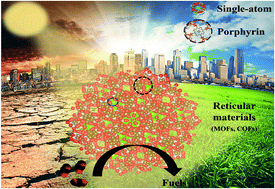Porphyrin and single atom featured reticular materials: recent advances and future perspective of solar-driven CO2 reduction
Abstract
The release of large volumes of anthropogenic CO2 coupled with growing exploitation of fossil fuels has led to very serious issues such as global warming and energy crisis in the world. One of the most promising solutions for addressing these challenges is photocatalytic reduction of CO2 into useful chemical feedstocks. The adsorption/activation and reduction of CO2 on the surface of heterogeneous catalysts, in addition to visible light harvesting and efficient charge separation, remains a scientifically challenging problem, which is severely limiting the total photoconversion and selectivity of CO2 reduction on photocatalysts. Reticular materials such as metal organic frameworks (MOFs) and covalent organic frameworks (COFs) are a class of porous materials, which have lately been investigated as photocatalysts due to their excellent tuneable structural and photochemical properties. Single-atom catalysts offer great potential to enable chemical transformation of CO2 when anchored to an appropriate support material. Naturally abundant porphyrin has been effective for a variety of processes including light-harvesting, oxygen transport and catalytic processes. The rigidity, robustness, and multifunctionality of reticular materials enable them to be used in a spectrum of applications. Modular optimization, rational design and integration of single-atoms and porphyrin onto metal- and covalent-organic frameworks pave a new pathway toward the photoreduction of CO2. In the context of recent advancements in the field of reticular materials, porphyrin and single atom based MOFs and COFs towards photocatalytic CO2 reduction are summarised in this review. This review also includes discussion on the current breakthroughs in fundamental knowledge, reaction mechanisms, and pathways of CO2 photoreduction, as well as gives an overview of the approaches towards improving the CO2 reduction efficiency and selectivity of these reticular photocatalytic materials. Also, the challenges and perspectives of CO2 photoreduction over these heterogeneous catalysts have also been presented in this report.

- This article is part of the themed collection: Green Chemistry Reviews


 Please wait while we load your content...
Please wait while we load your content...